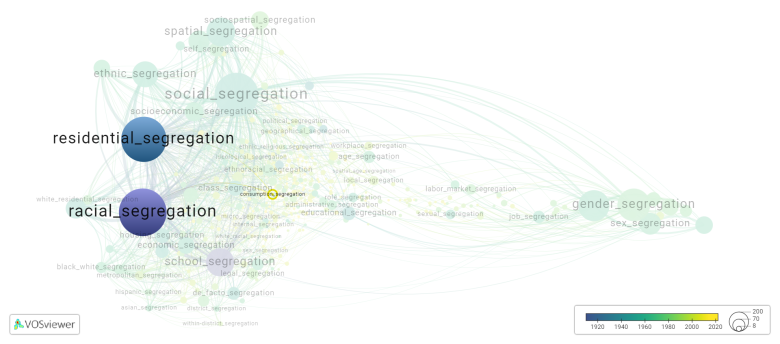Consumption segregation: Difference between revisions
(Creating page) |
(Creating page) |
||
| (7 intermediate revisions by 2 users not shown) | |||
| Line 1: | Line 1: | ||
===== Date and country of first publication<ref>Date and country of first publication as informed by the Scopus database (December 2023).</ref>===== | |||
2018<br> | |||
China | |||
===== Definition ===== | |||
Consumption segregation refers to the | Consumption segregation refers to the phenomenon where individuals or groups within a society segregate themselves based on their patterns of consumption. This segregation can manifest in various ways: | ||
1. Spatial Segregation: Certain neighborhoods or areas become associated with specific consumption patterns, such as luxury goods, organic products, or ethnic cuisine. This can lead to physical separation of groups based on their economic status or cultural preferences. | |||
For example, | 2. Social Segregation: Consumption habits can also segregate people socially. For example, certain social groups may engage in conspicuous consumption of high-status goods, thereby signaling their wealth or social standing. This can create barriers or distinctions between different social classes or groups. | ||
Consumption | 3. Cultural Segregation: Consumption choices can be influenced by cultural factors, such as religious dietary restrictions or preferences for specific types of products. This cultural segregation can reinforce social or ethnic boundaries within a community. | ||
4. Digital Segregation: In the digital age, consumption patterns can also segregate individuals online. Algorithms on social media and e-commerce platforms can tailor content and recommendations based on previous consumption behavior, potentially reinforcing existing preferences and segregating individuals into digital echo chambers. | |||
Overall, consumption segregation highlights how consumption choices can contribute to social stratification and reinforce existing inequalities or distinctions within society. | |||
==See also== | ==See also== | ||
==Related segregation forms== | |||
Consumption segregation is frequently discussed in the literature with the following segregation forms: | |||
[[residential segregation]], [[racial segregation]] | |||
[[File:consumption_segregation.png|780x780px]] | |||
This visualization is based on the study [[Segregation_Wiki:About| The Multidisciplinary Landscape of Segregation Research]]. | |||
For the complete network of interrelated segregation forms, please refer to: | |||
* [https://tinyurl.com/2235lkhw First year of publication] | |||
* [https://tinyurl.com/2d8wg5n3 Louvain clusters] | |||
* [https://tinyurl.com/223udk5r Betweenness centrality] | |||
* [https://tinyurl.com/244d8unz Disciplines in which segregation forms first emerged (Scopus database).] | |||
==References== | ==References== | ||
==Notes== | ==Notes== | ||
<references /> | <references /> | ||
{{NoteAI}} | {{NoteAI}} | ||
== | ==Consumption segregation appears in the following literature== | ||
Davis D.R., Dingel J.I., Monras J., Morales E. (2019) How segregated is urban consumption?. ''Journal of Political Economy'', ''127''(4), 1684-1738. University of Chicago Press. | Davis D.R., Dingel J.I., Monras J., Morales E. (2019). How segregated is urban consumption?. ''Journal of Political Economy'', ''127''(4), 1684-1738. University of Chicago Press.https://doi.org/10.1086/701680 | ||
Latest revision as of 07:17, 16 October 2024
Date and country of first publication[1][edit | edit source]
2018
China
Definition[edit | edit source]
Consumption segregation refers to the phenomenon where individuals or groups within a society segregate themselves based on their patterns of consumption. This segregation can manifest in various ways:
1. Spatial Segregation: Certain neighborhoods or areas become associated with specific consumption patterns, such as luxury goods, organic products, or ethnic cuisine. This can lead to physical separation of groups based on their economic status or cultural preferences.
2. Social Segregation: Consumption habits can also segregate people socially. For example, certain social groups may engage in conspicuous consumption of high-status goods, thereby signaling their wealth or social standing. This can create barriers or distinctions between different social classes or groups.
3. Cultural Segregation: Consumption choices can be influenced by cultural factors, such as religious dietary restrictions or preferences for specific types of products. This cultural segregation can reinforce social or ethnic boundaries within a community.
4. Digital Segregation: In the digital age, consumption patterns can also segregate individuals online. Algorithms on social media and e-commerce platforms can tailor content and recommendations based on previous consumption behavior, potentially reinforcing existing preferences and segregating individuals into digital echo chambers.
Overall, consumption segregation highlights how consumption choices can contribute to social stratification and reinforce existing inequalities or distinctions within society.
See also[edit | edit source]
Related segregation forms[edit | edit source]
Consumption segregation is frequently discussed in the literature with the following segregation forms:
residential segregation, racial segregation

This visualization is based on the study The Multidisciplinary Landscape of Segregation Research.
For the complete network of interrelated segregation forms, please refer to:
References[edit | edit source]
Notes[edit | edit source]
- ↑ Date and country of first publication as informed by the Scopus database (December 2023).
At its current state, this definition has been generated by a Large Language Model (LLM) so far without review by an independent researcher or a member of the curating team of segregation experts that keep the Segregation Wiki online. While we strive for accuracy, we cannot guarantee its reliability, completeness and timeliness. Please use this content with caution and verify information as needed. Also, feel free to improve on the definition as you see fit, including the use of references and other informational resources. We value your input in enhancing the quality and accuracy of the definitions of segregation forms collectively offered in the Segregation Wiki ©.
Consumption segregation appears in the following literature[edit | edit source]
Davis D.R., Dingel J.I., Monras J., Morales E. (2019). How segregated is urban consumption?. Journal of Political Economy, 127(4), 1684-1738. University of Chicago Press.https://doi.org/10.1086/701680
